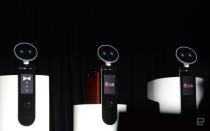People don't want to talk to LG's big friendly robots
But the company thinks artificial emotion could be the solution.
Last year was when talking to a smart speaker started to become the norm, but surprisingly, LG has struggled to replicate the same success with its CLOi series commercial robots. Ahead of LG's CES show, I talked to its Head of Research for Life Robots, Jaewon Chang, who updated on the company's robot trial service in South Korea's Incheon International Airport. Since deployment in July, each of the five Guide Robots has interacted with around 2,500 people. However, only a quarter of travelers used voice interaction, with the majority preferring the touchscreen mounted vertically on the robot's chest. Likewise, just as few people let the robots guide them to their destination. Chang needs to find a way to boost those figures -- and make us learn to trust these big friendly robots. "There are still psychological barriers in using voice recognition and also following robots around for directions," Chang said. "They feel this awkwardness and some degree of hesitation." Having interacted with Pepper out in the wild on several occasions, I questioned whether a more humanoid form factor -- or at least the addition of arms -- would help. While Chang admitted that he's interested in humanoids and that his team will ultimately add arms to its robots, initially those limbs would be largely decorative, gesturing aside. Then there's also the issue of how certain cultures perceive humanoid robots: Chang pointed out that Japan may have its friendly Astro Boy, but American folks will bring up the ruthless Terminator as a counterexample. "To take away the awkwardness, we need to change the [conceptual] perception of the users ... adding arms won't solve that issue. It's up to companies to gain more trust from the consumers, making them believe in our products more," Chang explained. He added that this will eventually change when those arms become sophisticated enough to perform meaningful tasks. For Chang, the missing ingredient in many robots right now is artificial emotion. We're not talking about having a humanlike face here; specifically, it's the combination of recognizing the user's mood and responding accordingly, with the former relying on video-recognition artificial intelligence -- something that Chang believes the industry as a whole should put more effort into. This is where the much smaller CLOi Hub Robot comes in. Much like its siblings, the Hub Robot also features a circular face showing a pair of jade-colored eyes that can animate a range of expressions; and unlike the ASUS Zenbo, it doesn't feature a mouth. (Perhaps that's why the bot stopped talking to the presenter halfway through his keynote at CES.) Even though the machine lacks mobility, it's able to wiggle on the spot to pull some cute moves or even dance to music. Better yet, on top of common interactions like proactively greeting, asking or making suggestions to a person, it claims to be capable of delivering appropriate emotional reactions based on the user's tone. I'm also looking forward to the Hub Robot's ability to control other LG home appliances -- a bit like using LG's own smart speaker except more fun. There's no word on when the bot will hit Western markets; all we know is that it'll be made available to Korean consumers in Q2 2018. Additionally, you can also expect the device to start serving customers in banks and shopping malls in the same region soon. It's still too early to tell whether the Hub Robot will be a commercial success. If anything, it seems that LG may actually have a better chance with its larger, slightly more imposing machines. "There are two major areas where we could see a real takeoff in commercial robots: hospitality and logistics," Chang added. "The logistics market is expected to be far greater than that of hospitality." Throughout the months of airport trialing, LG optimized its Guide Robots' voice-recognition technology for noisy environments, and it also improved the path-planning algorithm for both its Guide Robots and Cleaning Robots to better suit the busy floor. In the end, one of the Guide Robots accumulated a total travel distance of more than 120km within the airport building. Chang pointed out that thanks to the robots' exposure at Incheon Airport, his team received more trial requests from potential clients who had figured out other use cases -- hopefully ones that will encourage more voice interactions between machine and human. To that end, LG announced three new CLOi industrial machines at this year's CES: the Serving Robot, the Porter Robot and the Shopping Cart Robot. On top of that, Chang has been leading LG's development of two other robots since 2015: a robot vacuum cleaner and a lawn mower bot, with the latter expected to hit European markets in the second half of 2018. The company might not have made the perfect robot, but it's very aware of the challenges it still needs to overcome. It's not giving up anytime soon. Click here to catch up on the latest news from CES 2018.

















